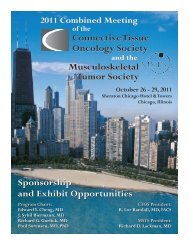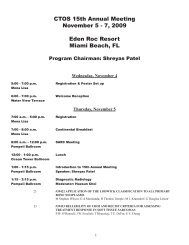207 Poster Session 2 - Connective Tissue Oncology Society
207 Poster Session 2 - Connective Tissue Oncology Society
207 Poster Session 2 - Connective Tissue Oncology Society
Create successful ePaper yourself
Turn your PDF publications into a flip-book with our unique Google optimized e-Paper software.
Scientific <strong>Poster</strong>s – <strong>Poster</strong> <strong>Session</strong> 2modulate cellular senescence, DNA repair, angiogenesis,epithelial-mesenchymal transition and metastasis.Conclusion: A prognostic miRNA signature consisting ofsix miRNAs has been successfully developed and validatedfor UPS. This signature could help identify patients at"High" risk for distant metastasis, who might benefit frommore aggressive systemic therapies or novel treatmentapproaches. Further, examination of the biological roles ofthese miRNAs in sarcoma could lead to the identificationof novel therapeutic targets which can impact on survivalfor future patients with UPS.<strong>Poster</strong> #148SOFT TISSUE SARCOMAS AND BONEMETASTASIS: PATHWAY PROTEINS INVOLVEDIN THE METASTASIS MICROENVIRONMENTAmalia Conti 2 ; Antonella Chiechi 2 ; Chiara Novello 1 ;Giovanna Magagnoli 1 ; Maria Serena Benassi 1 ; Piero Picci 1 ;Lance Liotta 2 ; Viriginia Espina 21Experiment <strong>Oncology</strong> Laboratory, Rizzoli OrthopaedicInstitute, Bologna, Italy; 2 Center for Applied Proteomicand Molecular Medicine, George Mason University,Manassas, VA, USAObjective: Soft-tissue sarcomas (STS) are a heterogeneousgroup of tumors that frequently have distant metastases.Although pathophysiology of bone metastases is wellknown, treatment still has a limited success. There istherefore a great need to develop new strategies employingmolecular targeted inhibitors. Proteomic molecular profilingcan identify pathways or specific proteins useful forpatient stratification and consequent treatment.The aim of this study was to investigate expression of keyproteins belonging to multiple signal transduction pathwaysand define their role in insurgence of STS and theirbone metastases in order to identify prognostic biomarkersand potential targets for molecular targeted therapies.Methods: 34 fresh frozen bone metastasis samples frompatients diagnosed with primary STS, 10 primary STSspecimens, 10 paired adjacent normal tissues, and as controlnon tumoral normal bone samples were completelyhomogenized using CryoPrepTM and Adaptative FocusAcousticTM (AFATM) technology by Covaris, with verygood protein extraction efficiency. Expression of 48 proteinsinvolved in bone metabolism, matrix breakdown, hormoneresponse, growth-proliferation, stress-inflammation andadhesive-cytoskeletal pathways was quantified by Reversephase protein arrays (RPMA).Results: By Mann Whitney analysis we first comparedprimary STS, paired normal tissues and bone metastaseswith normal bone. Differential expression (p < 0.05) wasfound for proteins involved in bone metabolism (DKK1,WNT5a/B), matrix degradation (MMP11, MMP14), proliferation(PI3K, AKT, mTOR, mTOR S2448, 4EBP S37/46) andadhesive-cytoskeletal pathways (Fibronectin, Syndecan 1,FAK Y576/577, Shc Y317). When comparing only pairedsamples, proteins involved in adhesion pathways showeddifferent activation intensity. Spearman’s rho correlationindex between primary tumor and metastasis showedsignificant values for TNF alpha (ρs= 0.7143; p=0.0288)and TNFR1 (ρs= 0.7381; p=0.0229).Conclusion: These preliminary results reveal an activationstate of pathways that are involved in STS metastatizationto bone. A validation of these preliminary results is ongoingby using immunohistochemistry analysis on a largerseries of samples. Our comprehensive approach could leadto identification of proteins involved in tumor-microenvironmentcross talk as targets for new molecular targetedtherapies.<strong>Poster</strong> #149PATIENT-DERIVED XENOGRAFT MODELS FORSOFT TISSUE SARCOMASFrank Traub, MD, PhD 1 ; Jana Rolff 2 ; Dimosthenis Andreou 1 ;Maya Niethard 1 ; Carmen Tiedke 1 ; Anne Richter 1 ;Iduna Fichtner 2 ; Per-Ulf Tunn 11Tumororthopädie, HELIOS Klinikum Berlin Buch,Berlin, Germany; 2 Experimental Pharmacology,Max-Delbrück-Center for Molecular Medicine,Berlin, GermanyObjective: Well-characterized animal models are neededto improve the therapeutic outcome of soft tissue sarcomapatients. Xenograft sarcoma models are frequently used,but commonly derived from cell lines rather than fromprimary human sarcoma tissue. The objective of the presentstudy was to establish xenograft models of primaryhuman soft tissue sarcomas in immunodeficient mice. Inthese models novel therapeutic options will be evaluatedand predictive biomarkers can be defined.Methods: <strong>Tissue</strong> from ten primary human soft tissue sarcomaswas directly transferred from our surgical theatre tothe laboratory. The tumour samples were taken from representativeareas of the original tumour. The samples weredivided into two adjacent parts, one for further histologicalanalysis (conventional light and immunohistochemistry)and the other for the in vivo experiment. A fragment fromeach tumor tissue was transplanted subcutaneously intoseveral (3-5) mice.Results: Five out of 10 derived sarcoma xenografts could besuccessfully established leading to solid tumors. Histologi-242






